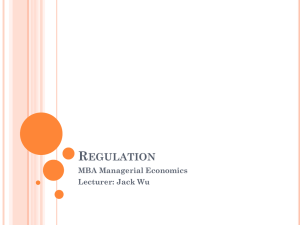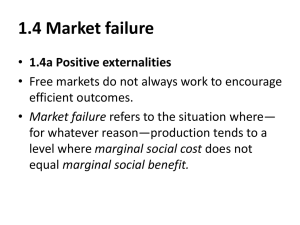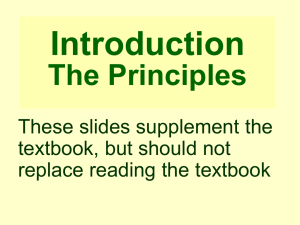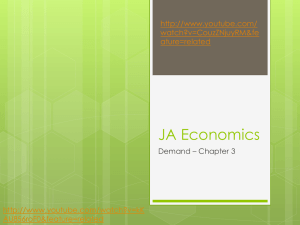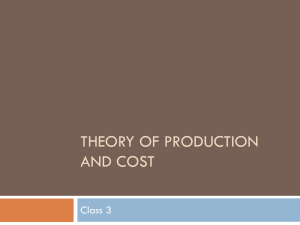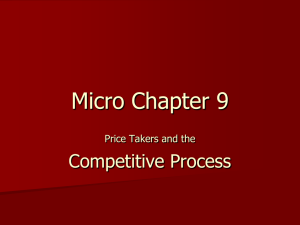publicgoods
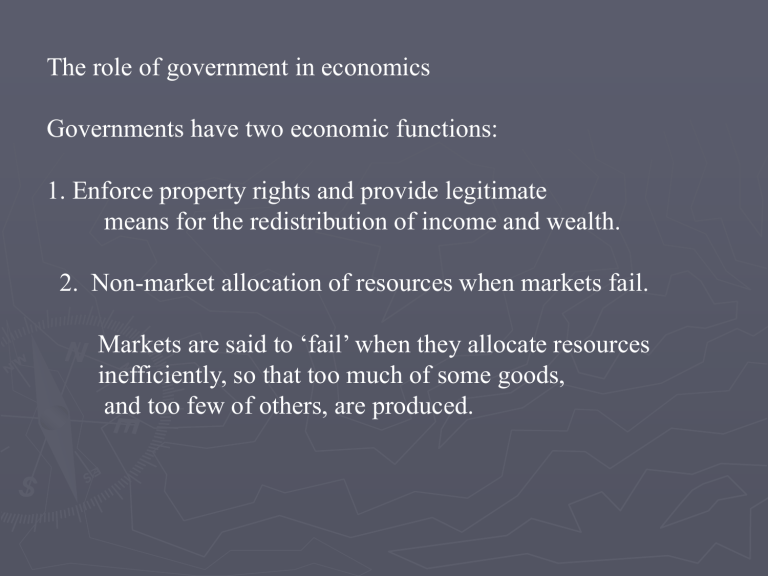
The role of government in economics
Governments have two economic functions:
1. Enforce property rights and provide legitimate means for the redistribution of income and wealth.
2. Non-market allocation of resources when markets fail.
Markets are said to ‘fail’ when they allocate resources inefficiently, so that too much of some goods, and too few of others, are produced.
Market Failure: Sometimes markets fail to allocate resources efficiently. There are four main types of market failure.
1. Public goods
2. Taxes and redistribution
3. Concentration of monopoly power
4. Externalities
Public Good: A good or service that can be consumed simultaneously by everyone and from which no one can be excluded.
Non-rival: Everyone can consume it at the same time.
Non-exclusion: No one can be excluded from consuming it.
There are many classes of goods, and some exhibit one or both of these features to some degree.
Excludable
Rival
(Pure Private Good)
Most consumer goods
Non-excludable
Rival
Clean air and water
Excludable
Non-rival
Cable TV
Highways
Movies
Non-excludable
Non-rival
(Pure Public Good)
National Defense
Only pure private goods can be allocated efficiently through the market without some kind of market failure.
Many goods that are based on networks, such as highways, railroads, communications lead to some kind of market failure that often leads to some kind of government action.
Though excludability can be difficult, it’s the non-rival nature of consumption that leads to the market failure most of the time.
For private goods: The marginal benefit is the maximum amount a person is willing and able to pay for one more unit.
For public goods: The marginal benefit is the maximum amount everyone together is willing to pay for one more unit of the good.
For private goods: We find market demand by adding the individual demand curves of consumers horizontally .
For public goods: We find the marginal benefit curve or society’s demand curve by adding individual marginal benefit curves vertically, because each person consumes each unit of the public good.
The efficient provision of a public good occurs at the quantity where the marginal benefit equals the marginal cost, or, where the net benefit, (total benefit -total cost of provision) is maximized.
But, since a public good is non-excludable, people have no incentive to pay for the good. They can’t be excluded from consuming it, so, whether they pay or not, they receive it.
And, since it is non-rival, each person consumes all of it at the same time.
So, people will take a free ride when they can, and not pay or not report the true value of a public good, because they consume it any time it is provided, whether they pay for it or not.
Because of the free rider problem, individuals have no incentive to pay for public goods, and therefore, private firms fail to provide the good.
Instead, a public agency is required to provide pure public goods.
A well informed and rational voting public can bring about efficient provision of public goods. But, individuals often do not have an economic incentive to be rational or informed as voters.
The economic theory of government: Economists look at most decisions as maximizing decisions in some way.
Politicians : Rational politicians maximize getting their policies enacted, given the fact that they face opposition. They find compromise solutions to get at least some of what they want. This can be efficient if voters are rational and informed.
Bureaucrats: Economists assume that rational bureaucrats act to maximize their budgets and job security.
Voters: Economists assume voters are rational and informed, but that it is rational for voters to be ignorant of any issue that has no bearing on their income. Therefore, voters may be rationally ignorant.
It is argued by economists that with rational voter ignorance and special interest groups pursuing their own agendae, then public goods can be over provided..ie. Inefficiency exists in public good provision.
Two theories of government:
Public interest theory: Voters are rational and informed, and refuse to vote for outcomes that can be improved upon.
Outcomes in this theory are efficient. (Analogous to perfect competition)
Public Choice theory: Voters are rationally ignorant. Special interests vote their own interests. Bureaucrats maximize their budgets and job security. Public outcomes are inefficient.
Government provision of public goods may be large and growing
For two basic reasons.
Voter preference: If the income elasticity of public goods is greater than 1, then, as the economy grows, demand for public goods will grow faster than the economy.
Overprovision: Inefficient public over provision can occur because of the workings of government as described above.
Taxes: There are many methods of taxation.
Income taxes } Federal
Social security taxes } Federal
Sales taxes } State, City, Local
Excise taxes } Federal, State, City, Local
Property taxes } Local
Income taxes are the main source of revenue for the Federal
Government.
Marginal tax rate: per centage of an additional dollar taken in tax.
Average tax rate: per centage of income paid in tax.
As with any other tax, the income tax causes a dead weight loss.
http://www.quicken.com/cms/viewers/article/taxes/53942
If your taxable income is x:
X <$6000 or less
$6000<x<$28,400
$28,400<x<$68,800
$68,800<x<$143,500
$143,500<x<$311,950
$311,950 < x
Then your tax is:
10% of your taxable income
$600 +15% of the amount over $6000
$3,960 + 27% of the amount over $28,400
$14,868 +30% of amount over $68,800
$37,278+35% of amount over $143,500
$96,235.50 + 38.6% of amount over $311,950
Most taxes create a dead-weight loss of some kind, depending on
Price elasticities of demand and supply.
In general, societies try to tax goods that have little dead weight loss, that is, goods with either low price elasticities of demand or low price elasticities of supply.
Income taxes, though, are important because:
1. They can be collected as income is earned (withholding)
2. They can raise large amounts of revenue with relatively low rates.
In the USA, we have a progressive income tax, because it is based on the concept of ability to pay.
Monopoly power and regulation:
When there is considerable monopoly power, there is often a move to regulate that power. But, this may or may not be in the public interest.
Two theories of regulation:
Public interest theory: Regulation is enacted to correct the inefficiencies in markets with considerable monopoly or monopsony power.
Capture theory: Producers manipulate government to enact regulations that maximize economic profit, regardless of the public interest.
Types of regulation: In the USA, most regulation is handled by a commission or some sort that controls the price charged and quantity produced.
Natural Monopoly : These firms are ‘naturally’ large because of the technology they use, with large economies of scale.
Average cost pricing : Pick Q where P = ATC
Marginal cost pricing : Pick Q where P = MC
Rate of return regulation : Guarantee a profit rate or level of profit.
Price cap regulation : Set a price ceiling for the firm.
Earning shares regulation : any profits earned are shared with the consumers of the good.
Producer interest regulation: Sometimes, government might support a type of regulation that helps the producers, to the detriment of the consumer.
Much farm regulation, with support prices, subsidies, and the like, are done to help industries, not consumers.
Anti-trust Law: In the USA, Anti-trust Laws were enacted to prevent monopoly power or unfair business practices.
It is illegal to restrain trade, fix prices, use unfair price discrimination, to be a monopoly, or to intend to be a monopoly.
The court is guided by ‘the rule of reason’. This means that monopolies or accumulations of monopoly power need not be illegal, but only if there is unreasonable restraint of trade.
The Microsoft Case: The Federal Government charged
Microsoft with: a. Monopoly power in the market for operating systems.
b. Predatory pricing and tying arrangements for browsers c. Using anti competitive practices in both markets.
The barriers to entry for Microsoft are economies of scale and network economies.
Predatory pricing was indicated by Microsoft giving away
IE, an attempt to drive out competitors. Now, IE is part of Windows, so, it is a ‘tied product’.
A settlement was reached with the Federal Government,
And compliance can be monitored at http://www.usdoj.gov/atr/cases/ms_index.htm
Market Externalities:
Externalities from production: Discharge into a creek from a manufacturing process.
Externalities from consumption: second hand cigarette smoke.
When we discuss marginal cost in production, we’ve been assuming that marginal external costs are zero, so that marginal private cost = marginal social cost.
But, Marginal Social Costs = Marginal Private Costs + Marginal
External Costs
Marginal external costs cannot be captured by the market process for allocating the good..they are external to the market.
But, external costs are real, they are just not covered by the market process..they are still paid by someone, but inefficiently.
$/ton
F
G
Marginal Social Cost
E
Market
Supply-
MPC
Demand
1000 tons/month
EFG represents the dead weight loss.
E is the inefficient market equilibrium.
F is the efficient equilibrium, including external costs.
Can a market ever handle external costs? Yes, in the ideal case of perfect property rights, described by
Ronald Coase.
Coase Theorem: Private transactions can lead to efficient outcomes when market externalities exit if:
1. There are only a small number of parties involved.
2. Transactions costs are low.
3. Property rights are assigned.
In these cases, private individuals will take all costs and benefits into account.
On the benefit side of the market, external benefits mean
That marginal private benefits no longer equal marginal social benefits. Any external benefits should be added to the market demand curve.
S-marginal cost
$/student/year
G
F
E
Marginal social
Benefit
D-marginal
Private benefit
Millions of
Students per year
Point E is the inefficient market outcome.
There is under-provision of the good, education.
F - gives efficient social outcome quantity.
EFG - shows dead weight loss from under-provision.
This kind of inefficiency can be solved by subsidy, public or private, tradable permits (vouchers) or other means.



